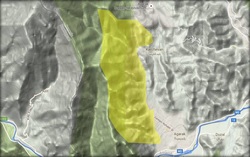|
General description:
The area (about 1463 ha) is located on eastern slopes of the southern end of Zangezur mountain ridge at elevations from 585 to 1890 m above sea level. The average slope steepness of the area is from 14˚ to 32˚. The area includes rocky semi-desert, wormwood semi-desert, variegated semi-desert, and scrubland semi-desert, juniper woodland, riparian scrubs, edge of deciduous forest, and orchards. Dominant vegetation among herbs are wormwood (Artemisia sp.), devil's-milk (Euphorbia sp.), feather grass (Stipa sp.), Prangos sp., Ferula sp., reed (Phragmites sp.); among scrubs are Atraphaxis sp., Christ's-thorn (Paliurus spina-christi), Acantholimon sp., blackberry (Rubus sp.); among trees are juniper (Juniperus polycarpos) mulberry (Morus sp.), hackberry (Celtis glabrata), walnut (Juglans regia), oak (Quescus araxinus), maple (Acer iberica), and fruit trees. The lower range of the area is characterized by hot and dry climate, however riparian area is quite humid and the orchards are well irrigated, and the at higher elevations it is moderately humid. Description of butterfly diversity: Number of butterfly species in the area – 69 (29% of total number of species in Armenia). None of the species included in IUCN Red List, 3 species are included in European Red List, and 1 species is included in National Red Data Book. The species of national and international concern: Gegenеs nostrodamus, Zegris eupheme, Pieris krueperi, Proterebia afra, Pseudochazara telefassa, Chazara briseis, Cupido argiades, Pseudophilotes vicrama. Threats: The area has been heavily littered by open pit mine waste, which changes the unique rocky and variegated semi-deserts completely. The same changes have been made by construction of roads for the same open pit mine. At current it is hard to say – whether the area was inhabited by Critically Endangered Polyommatus damonides, which disappeared before it was discovered or not. However the remains of the unique variegated semi-desert tell that it suits habitat conditions of the species. The rocky areas are the only ones that hosts Krueper's Small White Pieris kueperi – the habitat specialist that inhabits only Agarak area within the Meghri district. Many of butterfly species, including such species of concern as Dingy Swift Gegenеs nostrodamus and Short-tailed Blue Cupido argiades are inhabiting orchards only and intensification of use of insecticides might affect their populations significantly. About 50% of the area is within the borders of Zangezur Biosphere Complex. The remaining 50% however includes distribution ranges of all the species of special concern including entire isolated populations of Gegenеs nostrodamus, Pieris krueperi, Pseudochazara thelephassa, and Cupido argiades,and significant portions of populations of Zegris eupheme and Proterebia afra. For protection of butterfly diversity of orchards it is important to keep the mosaic structure of the arable lands, and to adopt environmentally friendly practices of pest control. In addition, development of ecotourism in the area will support in sustainability of area protection. In 2014, after designation of PBA status to the area, part of it was included into network of Emerald Sites. Butterfly-watching trail "Agarak" was designated, and personnel of the National Park was trained in species identification and trail guiding. |
© BirdLinks Armenia NGO, 2014
Charity Registration Number 03A968527
Charity Registration Number 03A968527





